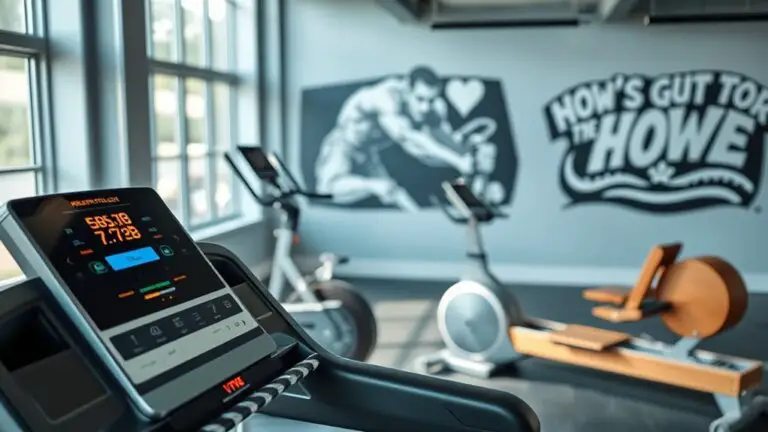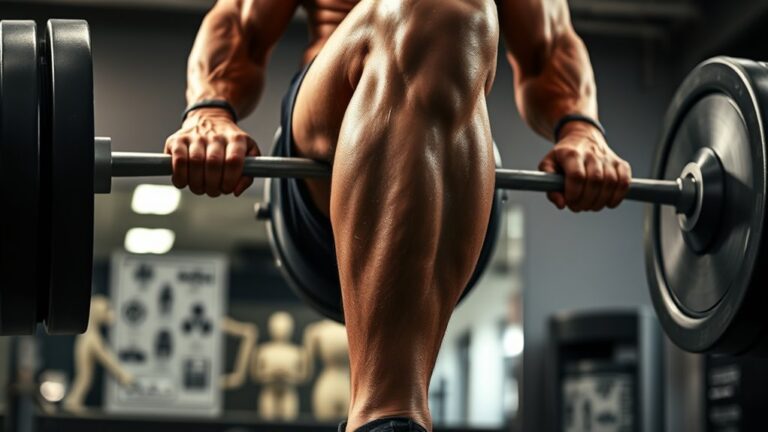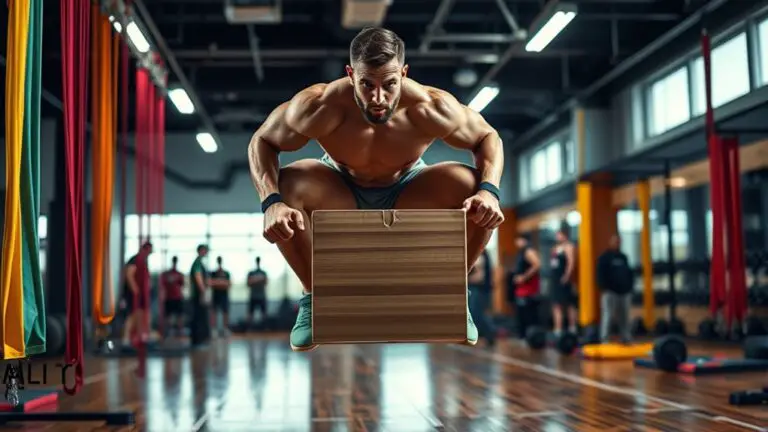The Best Gym Workouts for Swimmers to Build Upper Body Strength

To build upper body strength as a swimmer, focus on exercises targeting your shoulders, back, and arms. Try shoulder workouts like band pull-aparts and overhead presses, while incorporating bent-over rows and lat pulldowns for your back. Don’t forget arm workouts like pull-ups and tricep dips to enhance pulling power. Aim for 2-3 strength sessions weekly for best gains. Ready to explore specific routines and tips for maximizing your strength training?
The Importance of Upper Body Strength for Swimmers
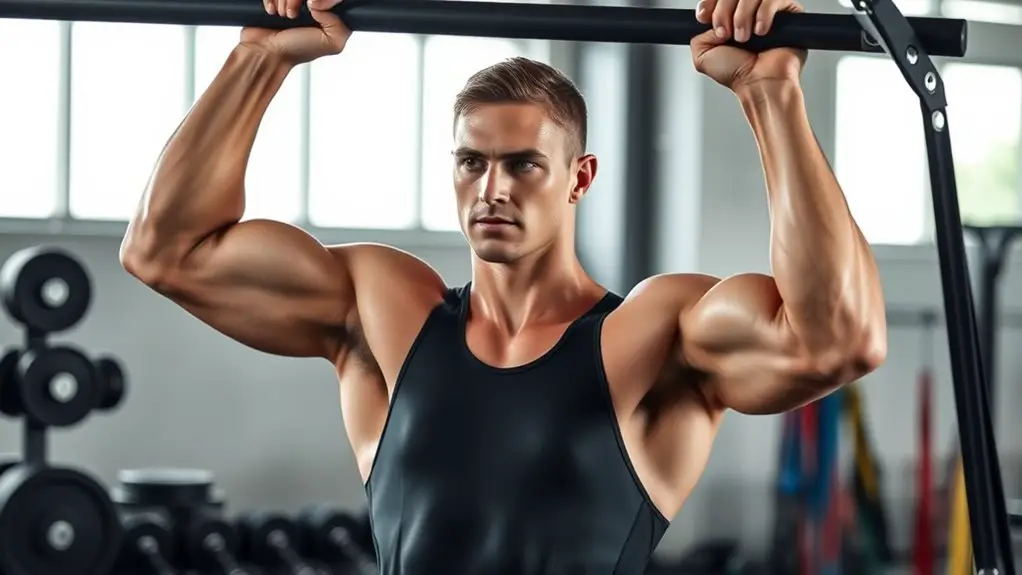
Upper body strength is essential for swimmers looking to enhance their performance in the pool. By focusing on strength training, you can improve your stroke efficiency, reduce the risk of injury, and increase your overall power in the water. Strong arms, shoulders, and back muscles provide better propulsion, allowing you to swim faster and longer.
When incorporating upper body strength training into your routine, always prioritize safety. Start with proper warm-ups to prevent strains, and choose weights that match your skill level. Exercises like pull-ups, push-ups, and resistance band work can effectively build the muscles vital for swimming.
Additionally, consider mixing in exercises that promote flexibility to maintain a full range of motion. Remember, a balanced approach to strength training not only boosts your swimming capabilities but also keeps you safe and healthy in the process. Focus on gradual progression, and you’ll see improvements without risking injury.
Essential Muscle Groups Targeted in Swimming
When you swim, several key muscle groups come into play, particularly in your upper body. Strengthening these areas not only boosts your performance but also helps prevent injuries. Let’s explore the essential muscles that contribute to your swimming success.
Key Muscle Groups
Swimming requires the engagement of several key muscle groups to maximize performance and efficiency in the water. Focusing on your upper body, you’ll primarily work your shoulders, back, and arms. These muscles are essential for powerful strokes and effective propulsion. Additionally, maintaining core stability is important; a strong core helps you stay streamlined and balanced, reducing drag. Don’t forget about grip strength—it’s critical for holding onto the water effectively during each stroke. By incorporating exercises that strengthen these muscle groups, like pull-ups and rows, you’ll enhance your swimming performance while also promoting safety. Always remember to warm up and use proper form to prevent injuries. Prioritizing these muscle groups will help you swim more efficiently and confidently.
Importance of Upper Body
Engaging your upper body is essential for effective swimming, as it directly influences your stroke power and efficiency. The primary muscle groups involved include your shoulders, back, and arms. Developing upper body endurance is vital; it allows you to maintain strong, consistent strokes over longer distances. When your upper body muscles are well-conditioned, you’ll notice a significant improvement in your swimming performance. Stronger shoulders help stabilize your strokes, while a powerful back enhances your pull in the water. Incorporating targeted exercises in the gym can build this strength safely, reducing the risk of injury. By prioritizing upper body workouts, you’ll boost both your endurance and overall effectiveness in the pool, leading to better results in your swimming endeavors.
Effective Gym Exercises for Shoulders

To enhance your shoulder strength and stability, incorporating effective gym exercises is essential. Focusing on shoulder mobility while using resistance bands can help prevent injuries and improve your performance in the pool. Here are four exercises you should consider:
- Band Pull-Aparts: Stand with your feet shoulder-width apart, holding a resistance band. Pull the band apart, squeezing your shoulder blades together. This promotes shoulder mobility and stability.
- Overhead Press: Use light dumbbells to avoid strain. Press the weights overhead, ensuring your core is engaged to maintain proper form.
- Lateral Raises: With dumbbells, lift your arms to the side, keeping a slight bend in your elbows. This targets the deltoids effectively.
- Face Pulls: Attach a resistance band to a high anchor point, pulling it towards your face. This strengthens the rear deltoids and improves posture.
Incorporate these exercises for safer and more effective shoulder training!
Strengthening Your Back for Improved Stroke
Your back muscles play an essential role in your swimming performance, supporting your strokes and helping maintain proper body alignment. Strengthening these muscles not only enhances your power and speed in the water but also reduces the risk of injury. Let’s explore some effective back exercises that can help you swim more efficiently.
Importance of Back Muscles
While many swimmers focus on their arms and legs, strengthening the back muscles is essential for enhancing stroke efficiency and overall performance in the water. Understanding back muscle anatomy and functions can greatly improve your technique. Here are four reasons why prioritizing back strength is vital:
- Enhanced stability: A strong back helps maintain proper body position, reducing drag.
- Improved power: Back muscles contribute to force generation, propelling you through the water.
- Injury prevention: A strong back supports proper posture, minimizing the risk of strain.
- Better recovery: Strengthening back muscles can aid in muscle recovery, allowing you to train harder.
Effective Back Exercises
Strengthening your back is key for any swimmer looking to enhance performance and efficiency in the water. Effective back exercises not only help improve your pulling techniques but also support overall stability during strokes. Incorporating resistance training is essential for building the muscles necessary for powerful pulls and streamlined movements.
Try exercises like bent-over rows or lat pulldowns, ensuring your form is correct to avoid injury. Start with lighter weights to focus on technique, gradually increasing resistance as you gain strength. Remember to engage your core for added support and maintain a controlled motion throughout each repetition. By prioritizing back strength, you’ll notice improved performance and reduced fatigue during your swim sessions.
Arm Workouts to Enhance Pulling Power
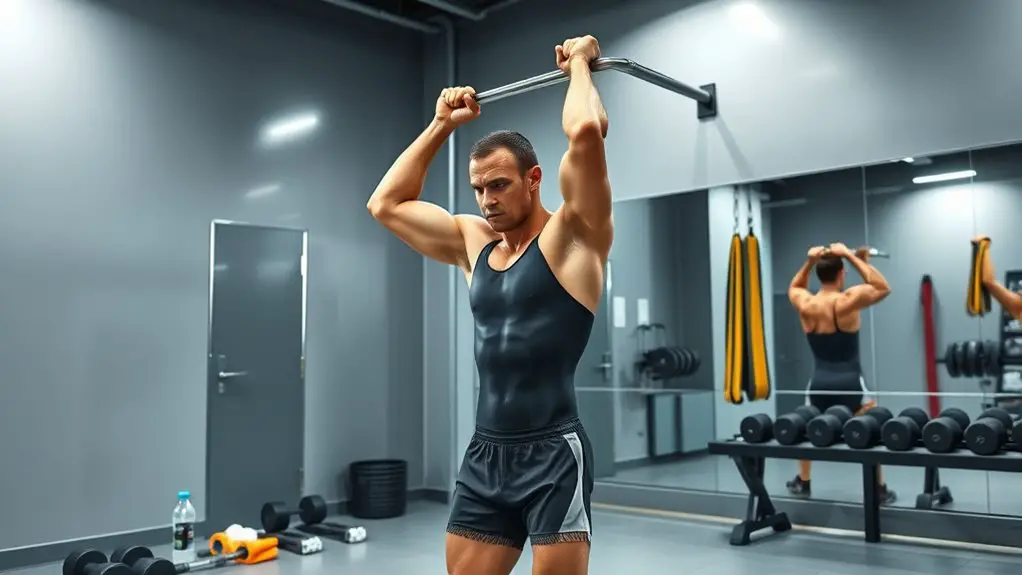
Building strong arms is essential for enhancing your pulling power in the water, and incorporating specific gym workouts can make a significant difference. Focus on exercises that improve your arm coordination and strengthen your pulling technique. Here are four effective arm workouts to boost your performance:
Building strong arms is crucial for enhancing your swimming performance through improved pulling power and coordination.
- Pull-Ups: Great for building overall upper body strength and targeting the biceps.
- Dumbbell Rows: Helps improve your pulling technique while engaging your back and arms.
- Tricep Dips: Strengthens the triceps, vital for the final push in your strokes.
- Bicep Curls: Isolate the biceps to enhance power and endurance during your swim.
Remember to start with a manageable weight and focus on form to reduce injury risk. Consistent training with these workouts can lead to noticeable improvements in your swimming performance, giving you the edge you need in the water.
Sample Workout Routine for Swimmers
A well-structured workout routine can make all the difference in a swimmer’s performance. Start your session with dynamic stretching techniques to warm up your muscles and improve flexibility. Aim for movements like arm circles and torso twists for about 10 minutes.
Next, focus on upper body strength with exercises like pull-ups, bench presses, and bent-over rows. Perform 3 sets of 8-12 reps for each exercise, ensuring you maintain proper form to prevent injury.
Incorporate core exercises such as planks and Russian twists to enhance stability.
After your workout, don’t forget to cool down with static stretching to aid recovery. Spend 10-15 minutes on stretches, targeting the shoulders, chest, and back.
Finally, consider recovery methods like foam rolling or light swimming on rest days to keep your muscles healthy and ready for the next session. This routine will help you build strength safely and effectively.
Frequently Asked Questions
How Often Should Swimmers Incorporate Gym Workouts Into Their Training?
You should ideally incorporate gym workouts into your training schedule two to three times a week. This frequency allows you to build strength without risking injury. It’s important to balance gym sessions with your swimming workouts, ensuring you’re not overtraining. Listen to your body and adjust as needed. Remember, consistency is key, but safety should always come first. Prioritize proper technique and recovery to maximize your performance in the water.
What Is the Best Time of Day to Do Strength Training?
Studies show that strength training in the morning can boost your metabolism by up to 15% for hours after your workout. If you prefer morning workouts, you’re likely to feel more energized throughout the day. However, evening sessions can also be beneficial, as your body may perform better when it’s warmed up. Ultimately, it’s essential to choose a time that suits your schedule while ensuring you prioritize safety and proper form.
Can Swimmers Skip Gym Workouts and Still Improve Performance?
While it might seem tempting to skip gym workouts, you shouldn’t overlook the gym benefits for swimmers. Strength training can enhance your swimming performance by building muscle and improving endurance. Without it, you could miss out on essential strength gains that help prevent injuries and boost overall efficiency in the water. Incorporating gym sessions into your routine complements your swim training and keeps you safe and strong for those challenging races.
Are There Any Specific Nutrition Tips for Strength Training Swimmers?
Have you ever wondered how nutrition can supercharge your strength training? For swimmers, focusing on protein timing is essential—aim to consume protein-rich foods within 30 minutes post-workout to support muscle recovery. Don’t forget hydration strategies; staying well-hydrated helps maintain performance and speeds up recovery. Incorporate electrolytes, especially during intense training sessions. Prioritizing these nutrition tips will help you maximize your strength training and enhance your overall swimming performance.
How Can Swimmers Prevent Injuries While Strength Training?
To prevent injuries while strength training, you’ll want to focus on proper technique and the right progression. Start with lighter weights to master your form, and don’t rush into heavier loads. Incorporating dynamic warm-ups and cooldown stretches can greatly aid in injury prevention. Listen to your body; if something feels off, don’t hesitate to take a break. Remember, consistency and safety are key to a successful strength training routine.


